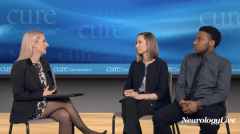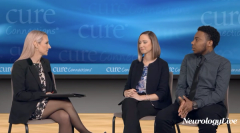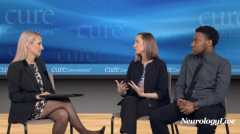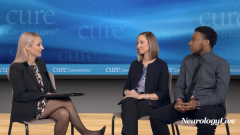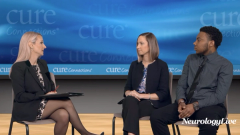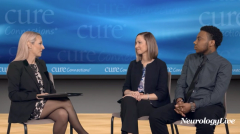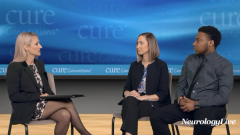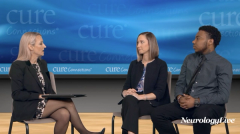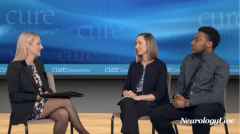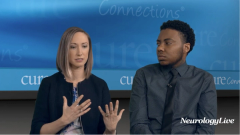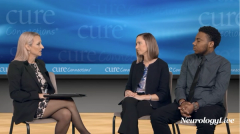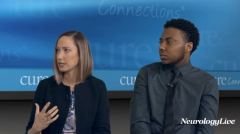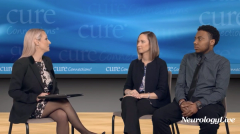
The Importance of Treating SMA Early
Episodes in this series

Philippa Cheetham, MBChB, MRCS, MD, FRCS: You mentioned, Sebastian, that you had physical therapy initially, and then some time goes by before Dr Proud contacts you out of the blue and says, “Hey, I've got this new magic treatment.” How frustrating is it to hear that you had been plodding on doing physical therapy and then there's a lag before out of the blue, you hear about a new treatment? Could Sebastian have received treatment earlier, do you think?
Crystal Proud, MD: So, that was 2018.
Sebastian Mills: Yes, I was in college.
Crystal Proud, MD: You were in college. It was 2018, and this first approved medication was on December 23 of 2016, so a little over maybe a year and a half.
Philippa Cheetham, MBChB, MRCS, MD, FRCS: How soon after hearing about this new treatment were you able to start it?
Sebastian Mills: I was a little apprehensive at first, honestly. I didn't believe it. I've been going this so long, and I don't believe this is going to work. But once I got home and I realized that it was taking a lot out of me to even pull myself off of the floor, I was like, “Okay, maybe I should try and at least see if this works.” So we went in, and it was my senior year, and we started trials.
Philippa Cheetham, MBChB, MRCS, MD, FRCS: Did you feel at that point that you made any progress going through physical therapy, or not really?
Sebastian Mills: I originally started physical therapy for the tight heel cord and the quadriceps. I made progress there. I had done water, I've done land, so I've done every type of physical therapy. I even had night splints. And I feel like I made some progress, but like I mentioned earlier, there was still something missing. So once I got to Dr Proud and she was like, “This is something that could probably boost all of that and help it from progressively getting worse,” I figured why not go ahead and give it a try once I noticed that I need to be optimistic about this situation.
Philippa Cheetham, MBChB, MRCS, MD, FRCS: Now Dr Proud, we hear about new drugs coming out all the time for all sorts of diseases, and patients who have these rare disorders hear about a new drug and they're like, “Wow, this is the holy grail.” Do you have a huge spectrum in terms of response to these treatments when you have a patient with spinal muscular atrophy [SMA]? Can you give a predicted, this is what we'd expect, or is it still extremely variable patient to patient?
Crystal Proud, MD: We know what the natural history of this disease implies. And so without treatment, I can clearly say and confidently say that if I gave Sebastian no medication, he would continue to have his motor nerves deteriorate over time and would reach a point where he would lose the ability to walk and would lose some of the motor neurons that help him to take a breath in and a breath out, leading to respiratory insufficiency. So without a doubt, I can say that progression and loss of function would happen with no treatment. With treatment, the world is our oyster.
And everyone is different, as you have mentioned. What we have seen from clinical trials and what I have seen in front of my eyes with the over 30 patients that we have on treatment at my center is, at a minimum, stability. And so when we talk about expectations in considering treatment, we talk about what our goals are. And my goal really is to maintain. Sebastian studied art, and I really wanted to make sure that those arm muscles that allowed him to do what he loved stayed strong, so that he could pursue a career and a family and wherever else life takes him. Stability really is my goal.
Philippa Cheetham, MBChB, MRCS, MD, FRCS: Of course, nerves don't usually regenerate, do they?
Crystal Proud, MD: Right.
Philippa Cheetham, MBChB, MRCS, MD, FRCS: Once you've lost function, you're not going to be able to improve what's been lost. You're really just delaying further deterioration.
Crystal Proud, MD: Well, to a degree. We've actually seen strengthening in our patients who have received treatment. It does not necessarily mean that that strengthening is coming from new nerves being regenerated because we know that physiologically, that's not possible. But we do believe that there are things happening at the cellular level, like a restructuring of the nerve where it's branching out to more muscles, perhaps strengthening at the neuromuscular junction. So, it's optimizing those nerves that are still present, that have not been lost.
Philippa Cheetham, MBChB, MRCS, MD, FRCS: When you’re describing these novel treatments to somebody like Sebastian, how do you start the conversation in terms of explaining the mechanism of action and the condition, this is what we hope to achieve? And how do you monitor whether somebody is responding? Is it literally as simple as saying, “Look, they're walking better, the measuring of the strength of the muscles is better?” How do you assess that?
Crystal Proud, MD: Oh, I wish it was that easy, but insurance really makes me do so much more. In starting the conversation, Sebastian may recall that I draw a lot of ugly pictures. Yes, I draw pictures of the brain, and then I draw an X, and I say, “Your brain is not impacted by this disease. You have a very smart, well-functioning brain,” as most of my patients do. And I draw the spinal cord, a little circle for where the motor nerves sit within the spinal cord, and then the projections out to the muscle.
And we talk about how that is the area where this disease impacts you. To understand how the treatments work, we have to talk about DNA. So, I talk a little bit about SMN1 gene and SMN2 gene. And that SMN1 gene is responsible in most people for producing that motor nerve protein that keeps those nerves healthy and connected to these muscles. There is a backup gene called the SMN2 gene, and that gene is a faulty gene.
It only produces that protein about 10% of the time. So in you and me, that may not matter that it's a faulty gene because we have that number 1 gene that's working well. But for Sebastian and patients with spinal muscular atrophy, he has a missing or mutated SMN1 gene. And so, his body is only relying on that backup SMN2 gene, and it's just not able to keep up with the protein needs that his motor nerves have.
Philippa Cheetham, MBChB, MRCS, MD, FRCS: So you're trying to upregulate the protein with these novel therapies.
Crystal Proud, MD: Absolutely.
Philippa Cheetham, MBChB, MRCS, MD, FRCS: I'm sure you get asked this question all the time in terms of regeneration of the nerves—stem cells. Is there any role for stem cell treatment in this disease?
Crystal Proud, MD: No, not at this time.
Philippa Cheetham, MBChB, MRCS, MD, FRCS: Do you get asked that question a lot?
Crystal Proud, MD: I do, but we've got cooler things than stem cells.
Philippa Cheetham, MBChB, MRCS, MD, FRCS: Sebastian, looking back now over the last 10 to 15 years, you’ve been on this journey with SMA since your early childhood. Looking back now and seeing where you are, do you see areas of your care when you think, “If only I could have gotten to this center, or I could have gotten this treatment?” Do you think there were significant delays in your treatment? Or if you could go back and start all over again, would you go down a different pathway to get better treatment, do you think? It seems like you had excellent treatment.
Sebastian Mills: I obviously wish it was there when I first noticed the big jump in weakness, but everything happens the way it's supposed to happen. So, I'm glad I met Dr Proud, and I'm glad I'm able to experience this and be on this journey with her and getting to understand medicine not only for myself but people around me who will need it, too.
Philippa Cheetham, MBChB, MRCS, MD, FRCS: What are the most challenging parts of having SMA for you right now? Are there some things that you want to do that you can't do?
Sebastian Mills: The weakness is the challenging point, but also that comes with the mentality of being able to know that you've got to push through it, too, and just trust that the medicine will do what it needs to do.
Philippa Cheetham, MBChB, MRCS, MD, FRCS: On a daily basis, when you're busy with work and social life and just living, how much does your disease impact you? Have you learned to kind of get on with life?
Sebastian Mills: Yes.
Philippa Cheetham, MBChB, MRCS, MD, FRCS: Or is it something you think about every day?
Sebastian Mills: I don't think about it as much as I used to. Like I said, I met Dr Proud when I was in college, so at that point, I kind of adapted mentally to it, that this is just something that I have and it's always going to be there. But at the same time, I think it's cool to think about it, too, at some point because it makes me want to be more open and express how I feel about it to other people. Even though I know it's there, and sometimes it gets on my nerves that it's there, I know it's a part of my life and I accept that. And then I also accept that there will be a time where I won't be worse off than I was.
Philippa Cheetham, MBChB, MRCS, MD, FRCS: We hear often when experts are talking to other doctors at lectures, international conferences, you always hear these key points at the end of a presentation about how these are the patients we want to see. We want earlier diagnosis. We want earlier treatment. So often with these rare diseases, there's a delay in getting the right patient to the right doctor at the right time. What would be your key points in talking to non-experts in neurology about how to get patients to you, or to get patients to get the right treatment? How do we break down these barriers of delayed diagnosis? How do we do a better job as a medical community?
Crystal Proud, MD: That's a great question. I think recognition is key. When you see weakness, and weakness that is progressive, even if it is slowly progressive. I have several of my colleagues in neurology who say to me, “But my patient with SMA is stable.” There is no such thing as stability and SMA. It is a constant deterioration of those motor nerves over time without treatment. And so recognizing that, I think, is the first key point.
There is no stability without treatment in SMA. Those patients need to have a discussion about options for treatment, even if they choose not to pursue that, and recognizing that this could potentially be a diagnosis in someone who's undiagnosed with this progressive weakness. Whether it is an older patient or an adult who was having tripping and falling episodes, or if it's a baby who is not meeting those motor milestones that would be expected, that is a time to pursue evaluation with a neurologist.
And a neurologist should keep this on their list of possibilities on their differential diagnosis. I consider it, like I said, a true neurologic emergency. Which is why my personal experience at my hospital is that if you call and say that, “I either have a patient with SMA that I'd like Dr Proud to see, or if I have SMA on my differential,” that patient is usually seen that day, the following day, or if they have to travel, I joke, as soon as they can get in the car and come down.
And I know many of my peers in neuromuscular neurology throughout the country feel very similarly. These are patients who we need to see quickly and institute treatment soon.
Newsletter
Keep your finger on the pulse of neurology—subscribe to NeurologyLive for expert interviews, new data, and breakthrough treatment updates.

